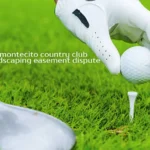Introduction to the Montecito Country Club Landscaping Easement Dispute
Amid Montecito’s blend of elegance and natural beauty, a legal clash has emerged, drawing interest from both residents and real estate followers. The Montecito Country Club landscaping easement dispute is not just about trees and shrubs; it’s a clash over rights, responsibilities, and community harmony. As tensions rise between neighboring properties and club management, many are left wondering: what happens when personal aesthetics collide with legal agreements? Join us as we delve into this intriguing case that highlights the complexities of property ownership in one of California’s most exclusive neighborhoods.
Background: What Led to the Dispute?
For years, the Montecito Country Club has stood as a treasured centerpiece of the community. Its lush landscaping is integral to its charm, enhancing the experience for both golfers and locals alike. Yet beneath the scenic beauty, a complex and heated dispute brews.
Central to the conflict is an easement, which grants one party permission to utilize another’s property for a defined use. For years, residents adjacent to the club enjoyed what they believed were their rights to certain landscaped areas. They viewed these spaces as extensions of their own properties.
Tensions began when changes in maintenance practices emerged at the country club. Some homeowners felt blindsided by alterations that affected their access and views. Discontent simmered until it eventually erupted into legal claims over ownership and usage rights.
This disagreement reflects broader themes about community responsibility versus individual interests—an ongoing negotiation between aesthetics and legality within shared spaces.
Court Ruling: What Did the Judge Decide?
The recent court ruling regarding the Montecito Country Club landscaping easement dispute has drawn significant attention. The judge’s decision favored one party, clarifying the rights associated with the disputed easement.
In her findings, she emphasized property rights and existing agreements. The ruling highlighted that prior documentation supported one side’s claims over access and maintenance responsibilities.
Additionally, the court examined evidence from both parties. Testimonies illustrated differing interpretations of what was originally intended for the easement in question. This played a critical role in shaping the final verdict.
This decision sets a precedent for similar disputes in Montecito and beyond. It underscores how essential clarity is when it comes to property agreements and shared spaces among homeowners associations or clubs alike.
The Arguments from Both Sides
The Montecito Country Club landscaping easement dispute brought forth strong arguments from both sides. Proponents of the easement emphasized its importance for maintaining aesthetic harmony within the community. They argued that well-kept landscaping enhances property values and provides a serene environment for all residents.
Opponents, however, contended that the easement infringed on their personal property rights. They claimed it limited their ability to modify or maintain their own yards as they saw fit. For them, this was more than just an aesthetic issue; it represented a fundamental right to exercise control over one’s property.
Furthermore, some residents expressed concerns about potential financial implications stemming from increased maintenance costs linked to adhering to specific landscaping standards set by the club. This clash between collective interests and individual freedoms made for a complex legal battle that captured significant attention in the community.
Implications of the Court Ruling
The court ruling on the Montecito Country Club landscaping easement dispute carries significant implications for future cases. It sets a precedent that could influence how easements are interpreted and enforced in similar communities.
Property owners may now feel more empowered to assert their rights over shared spaces. This decision highlights the importance of clear communication between homeowners associations and residents regarding landscaping responsibilities.
Moreover, it underscores the need for thorough documentation when establishing easements. Homeowners must ensure all agreements are clearly defined to prevent misunderstandings down the line.
For local governments, this case might encourage stricter regulations surrounding land use and easement agreements. As a result, property values could be affected as clarity increases in these legal frameworks.
In essence, this ruling serves as a reminder of the complexities involved in community living and shared property rights.
Lessons for Homeowners Associations and Property Owners
Homeowners associations (HOAs) and property owners can draw important lessons from the Montecito Country Club landscaping easement dispute. Communication is crucial. Regular discussions about shared spaces can prevent misunderstandings.
Transparency in decision-making is essential as well. When all parties understand the rules and regulations, conflicts are less likely to arise. Clear documentation of agreements helps protect everyone involved.
Property maintenance standards should be established collaboratively. Engaging members in setting expectations fosters a sense of community ownership, which often leads to better compliance with guidelines.
Dispute resolution mechanisms are also vital for HOAs. Having a fair process in place allows for quicker resolutions without escalating tensions or legal battles.
Staying informed about local laws regarding easements and property rights will empower both associations and homeowners to navigate complex issues confidently.
Conclusion: Resolving Easement Disputes Amicably
Disputes over easements, like the one seen at Montecito Country Club, can be complex and emotionally charged. They often stem from misunderstandings or differing interpretations of agreements. The court ruling sheds light on the importance of clear communication among all parties involved.
Homeowners associations and property owners should take this case as a learning opportunity. Establishing detailed guidelines about landscaping rights and responsibilities can help prevent conflicts before they arise. Open dialogue is essential; addressing potential issues early can foster goodwill within communities.
As difficult as these disputes may seem, amicable resolutions are always preferable to lengthy legal battles. Building trust between neighbors encourages collaboration rather than contention. Finding common ground not only preserves relationships but also enhances community spirit.
Navigating easement disputes requires patience, empathy, and a willingness to compromise. By prioritizing communication and understanding each other’s perspectives, homeowners can turn conflict into cooperation for a brighter future in their neighborhoods.
Curious hearts and bright minds—follow the path to more wisdom on TARNPLANEN.











